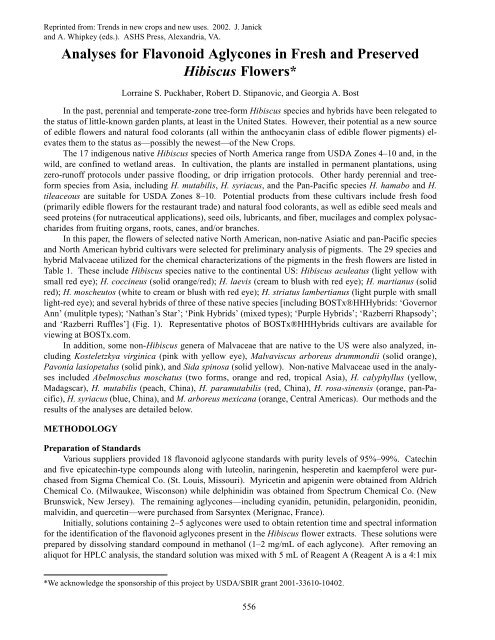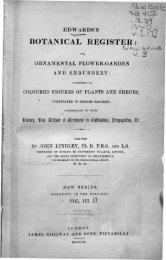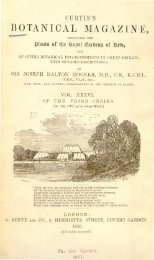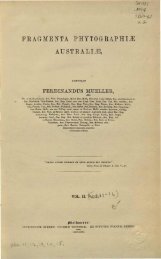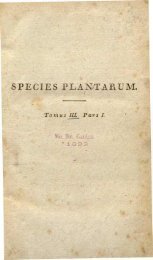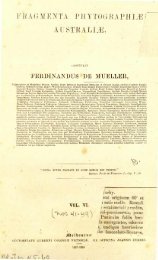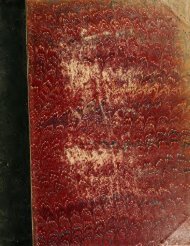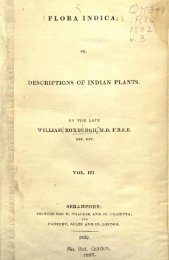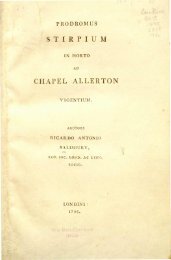Analyses for Flavonoid Aglycones in Fresh and Preserved Hibiscus ...
Analyses for Flavonoid Aglycones in Fresh and Preserved Hibiscus ...
Analyses for Flavonoid Aglycones in Fresh and Preserved Hibiscus ...
You also want an ePaper? Increase the reach of your titles
YUMPU automatically turns print PDFs into web optimized ePapers that Google loves.
Repr<strong>in</strong>ted from: Trends <strong>in</strong> new crops <strong>and</strong> new uses. 2002. J. Janick<br />
<strong>and</strong> A. Whipkey (eds.). ASHS Press, Alex<strong>and</strong>ria, VA.<br />
<strong>Analyses</strong> <strong>for</strong> <strong>Flavonoid</strong> <strong>Aglycones</strong> <strong>in</strong> <strong>Fresh</strong> <strong>and</strong> <strong>Preserved</strong><br />
<strong>Hibiscus</strong> Flowers*<br />
Lorra<strong>in</strong>e S. Puckhaber, Robert D. Stipanovic, <strong>and</strong> Georgia A. Bost<br />
In the past, perennial <strong>and</strong> temperate-zone tree-<strong>for</strong>m <strong>Hibiscus</strong> species <strong>and</strong> hybrids have been relegated to<br />
the status of little-known garden plants, at least <strong>in</strong> the United States. However, their potential as a new source<br />
of edible flowers <strong>and</strong> natural food colorants (all with<strong>in</strong> the anthocyan<strong>in</strong> class of edible flower pigments) elevates<br />
them to the status as—possibly the newest—of the New Crops.<br />
The 17 <strong>in</strong>digenous native <strong>Hibiscus</strong> species of North America range from USDA Zones 4–10 <strong>and</strong>, <strong>in</strong> the<br />
wild, are conf<strong>in</strong>ed to wetl<strong>and</strong> areas. In cultivation, the plants are <strong>in</strong>stalled <strong>in</strong> permanent plantations, us<strong>in</strong>g<br />
zero-runoff protocols under passive flood<strong>in</strong>g, or drip irrigation protocols. Other hardy perennial <strong>and</strong> tree<strong>for</strong>m<br />
species from Asia, <strong>in</strong>clud<strong>in</strong>g H. mutabilis, H. syriacus, <strong>and</strong> the Pan-Pacific species H. hamabo <strong>and</strong> H.<br />
tileaceous are suitable <strong>for</strong> USDA Zones 8–10. Potential products from these cultivars <strong>in</strong>clude fresh food<br />
(primarily edible flowers <strong>for</strong> the restaurant trade) <strong>and</strong> natural food colorants, as well as edible seed meals <strong>and</strong><br />
seed prote<strong>in</strong>s (<strong>for</strong> nutraceutical applications), seed oils, lubricants, <strong>and</strong> fiber, mucilages <strong>and</strong> complex polysaccharides<br />
from fruit<strong>in</strong>g organs, roots, canes, <strong>and</strong>/or branches.<br />
In this paper, the flowers of selected native North American, non-native Asiatic <strong>and</strong> pan-Pacific species<br />
<strong>and</strong> North American hybrid cultivars were selected <strong>for</strong> prelim<strong>in</strong>ary analysis of pigments. The 29 species <strong>and</strong><br />
hybrid Malvaceae utilized <strong>for</strong> the chemical characterizations of the pigments <strong>in</strong> the fresh flowers are listed <strong>in</strong><br />
Table 1. These <strong>in</strong>clude <strong>Hibiscus</strong> species native to the cont<strong>in</strong>ental US: <strong>Hibiscus</strong> aculeatus (light yellow with<br />
small red eye); H. cocc<strong>in</strong>eus (solid orange/red); H. laevis (cream to blush with red eye); H. martianus (solid<br />
red); H. moscheutos (white to cream or blush with red eye); H. striatus lambertianus (light purple with small<br />
light-red eye); <strong>and</strong> several hybrids of three of these native species [<strong>in</strong>clud<strong>in</strong>g BOSTx®HHHybrids: ‘Governor<br />
Ann’ (mulitple types); ‘Nathan’s Star’; ‘P<strong>in</strong>k Hybrids’ (mixed types); ‘Purple Hybrids’; ‘Razberri Rhapsody’;<br />
<strong>and</strong> ‘Razberri Ruffles’] (Fig. 1). Representative photos of BOSTx®HHHybrids cultivars are available <strong>for</strong><br />
view<strong>in</strong>g at BOSTx.com.<br />
In addition, some non-<strong>Hibiscus</strong> genera of Malvaceae that are native to the US were also analyzed, <strong>in</strong>clud<strong>in</strong>g<br />
Kosteletzkya virg<strong>in</strong>ica (p<strong>in</strong>k with yellow eye), Malvaviscus arboreus drummondii (solid orange),<br />
Pavonia lasiopetalus (solid p<strong>in</strong>k), <strong>and</strong> Sida sp<strong>in</strong>osa (solid yellow). Non-native Malvaceae used <strong>in</strong> the analyses<br />
<strong>in</strong>cluded Abelmoschus moschatus (two <strong>for</strong>ms, orange <strong>and</strong> red, tropical Asia), H. calyphyllus (yellow,<br />
Madagscar), H. mutabilis (peach, Ch<strong>in</strong>a), H. paramutabilis (red, Ch<strong>in</strong>a), H. rosa-s<strong>in</strong>ensis (orange, pan-Pacific),<br />
H. syriacus (blue, Ch<strong>in</strong>a), <strong>and</strong> M. arboreus mexicana (orange, Central Americas). Our methods <strong>and</strong> the<br />
results of the analyses are detailed below.<br />
METHODOLOGY<br />
Preparation of St<strong>and</strong>ards<br />
Various suppliers provided 18 flavonoid aglycone st<strong>and</strong>ards with purity levels of 95%–99%. Catech<strong>in</strong><br />
<strong>and</strong> five epicatech<strong>in</strong>-type compounds along with luteol<strong>in</strong>, nar<strong>in</strong>gen<strong>in</strong>, hesperet<strong>in</strong> <strong>and</strong> kaempferol were purchased<br />
from Sigma Chemical Co. (St. Louis, Missouri). Myricet<strong>in</strong> <strong>and</strong> apigen<strong>in</strong> were obta<strong>in</strong>ed from Aldrich<br />
Chemical Co. (Milwaukee, Wisconson) while delph<strong>in</strong>id<strong>in</strong> was obta<strong>in</strong>ed from Spectrum Chemical Co. (New<br />
Brunswick, New Jersey). The rema<strong>in</strong><strong>in</strong>g aglycones—<strong>in</strong>clud<strong>in</strong>g cyanid<strong>in</strong>, petunid<strong>in</strong>, pelargonid<strong>in</strong>, peonid<strong>in</strong>,<br />
malvid<strong>in</strong>, <strong>and</strong> quercet<strong>in</strong>—were purchased from Sarsyntex (Merignac, France).<br />
Initially, solutions conta<strong>in</strong><strong>in</strong>g 2–5 aglycones were used to obta<strong>in</strong> retention time <strong>and</strong> spectral <strong>in</strong><strong>for</strong>mation<br />
<strong>for</strong> the identification of the flavonoid aglycones present <strong>in</strong> the <strong>Hibiscus</strong> flower extracts. These solutions were<br />
prepared by dissolv<strong>in</strong>g st<strong>and</strong>ard compound <strong>in</strong> methanol (1–2 mg/mL of each aglycone). After remov<strong>in</strong>g an<br />
aliquot <strong>for</strong> HPLC analysis, the st<strong>and</strong>ard solution was mixed with 5 mL of Reagent A (Reagent A is a 4:1 mix<br />
*We acknowledge the sponsorship of this project by USDA/SBIR grant 2001-33610-10402.<br />
556
Herbs, Medic<strong>in</strong>als, <strong>and</strong> Aromatics<br />
of 62.5% aqueous methanol with 0.5 g/L tert-butylhydroqu<strong>in</strong>one <strong>and</strong> 6 N HCl) <strong>and</strong> refluxed <strong>for</strong> 2 hr. This<br />
reacted solution was also analyzed by HPLC.<br />
Two series of st<strong>and</strong>ard solutions (each series conta<strong>in</strong><strong>in</strong>g different aglycones found <strong>in</strong> the <strong>Hibiscus</strong> flowers)<br />
were analyzed by HPLC to determ<strong>in</strong>e the quantity of compound versus chromatograph peak area <strong>in</strong><strong>for</strong>mation.<br />
The most concentrated solution <strong>in</strong> each series was precisely prepared from four solid st<strong>and</strong>ards.<br />
Specifically, 300–500 µg of each of the four aglycones was weighed to the nearest 0.1 µg. The amounts were<br />
comb<strong>in</strong>ed, then dissolved <strong>and</strong> diluted to 5.00 mL with Reagent A. Next, the concentrate was diluted 1.00 mL<br />
to 10.00 mL <strong>and</strong> 0.100 mL to 10.00 mL with Reagent A to produce two other solutions <strong>for</strong> the series. The<br />
st<strong>and</strong>ard solutions were analyzed by HPLC us<strong>in</strong>g 2, 10, <strong>and</strong> 20 µL <strong>in</strong>jections.<br />
HPLC Analysis<br />
The LC system employed is a Hewlett-Packard (HP) 1050 Series modular system equipped with an 1100<br />
Series diode array detector <strong>and</strong> a HP Kayak computer with HP HPLC 3D ChemStation software <strong>for</strong> <strong>in</strong>strument<br />
operation <strong>and</strong> data analysis. The LC method uses a HP Zorbax Eclipse XDB-C18 column (250 × 4.6<br />
mm) preceded by a guard column of similar stationary phase. The columns are ma<strong>in</strong>ta<strong>in</strong>ed at room temperature.<br />
The mobile phase is run at 1.00 mL/m<strong>in</strong> <strong>and</strong> consists of a gradient of water, methanol (MeOH) <strong>and</strong><br />
A<br />
B<br />
C<br />
D<br />
Fig. 1. BOSTx®HHHybrids: (A) ‘Razberri Ruffles’, (B) ‘Michelle’s Passion’, (C) ‘Jacki’s K.O.’, <strong>and</strong> (D)<br />
‘Grace Coolidge’.<br />
557
Trends <strong>in</strong> New Crops <strong>and</strong> New Uses<br />
acetonitrile (ACN), each conta<strong>in</strong><strong>in</strong>g 0.05% trifluoroacetic acid. The gradient is as follows: 0–5 m<strong>in</strong> at 90%<br />
H 2<br />
O, 6% MeOH, <strong>and</strong> 4% ACN; 5–30 m<strong>in</strong> at 85%, 9%, <strong>and</strong> 6%; 30–60 m<strong>in</strong> at 71%, 17.4%, <strong>and</strong> 11.6%; 60–61<br />
m<strong>in</strong> at 0%, 85%, <strong>and</strong> 15%; 61–66 m<strong>in</strong> at 90%, 6%, <strong>and</strong> 4%. For the anthocyanid<strong>in</strong>s, the chromatogram signal<br />
is monitored at 520 nm (20 nm b<strong>and</strong>width) with reference to 570 nm (60 nm b<strong>and</strong>width) while, <strong>for</strong> all other<br />
flavonoid aglycones, the chromatogram signal is monitored at 210 nm (20 nm b<strong>and</strong>width) with reference to<br />
550 nm (100 nm b<strong>and</strong>width). In addition to the chromatogram signals, spectra are collected over 190–600<br />
nm. Spectra of peaks with<strong>in</strong> the flower extract chromatograms were compared to those of st<strong>and</strong>ards <strong>for</strong> identification<br />
purposes.<br />
Extraction of <strong>Fresh</strong> Flower Petals<br />
<strong>Fresh</strong> blossoms of 29 species <strong>and</strong> hybrids of <strong>Hibiscus</strong> were exam<strong>in</strong>ed over a course of 4 days (Table 1).<br />
The flowers from eight or fewer entries were harvested <strong>in</strong> the morn<strong>in</strong>g after blossoms were fully open, placed<br />
<strong>in</strong> clear domed trays <strong>and</strong> transported under air condition<strong>in</strong>g (as would be done <strong>for</strong> a fresh delivery to potential<br />
restaurant clients) to the laboratory, then stored at 2ºC <strong>in</strong> a laboratory cold room until extraction was per<strong>for</strong>med.<br />
Generally, four sets of two extractions were run concurrently <strong>for</strong> each day of freshly harvested samples,<br />
so that eight flower varieties could be exam<strong>in</strong>ed per day while limit<strong>in</strong>g the <strong>in</strong>terval between harvest <strong>and</strong> extraction<br />
to 10 hr.<br />
The extraction procedure was as follows: For small to very small flowers, 6–8 whole flowers were<br />
selected <strong>for</strong> extraction. For medium to large sized flowers, 4–6 petals from a s<strong>in</strong>gle flower were used, depend<strong>in</strong>g<br />
upon the size of the petals. Flower diameters range from as small as 3 cm (Pavonia spp.) to as large<br />
as 30 cm (<strong>Hibiscus</strong> hybrid cultivars).<br />
Whole flowers or <strong>in</strong>dividual petals (depend<strong>in</strong>g upon blossom size) were cut <strong>in</strong>to 2–5 mm by 5–10 mm<br />
pieces. Then, 1.0–1.2 g of fresh tissue were weighed to the nearest 0.1 mg <strong>in</strong>to a 50 mL round-bottom flask.<br />
The amount of tissue used <strong>for</strong> the air-dried <strong>and</strong> freeze-dried samples was ± 0.1 g, <strong>in</strong> order to atta<strong>in</strong> pigment<br />
concentrations comparable to fresh blossoms <strong>and</strong> compensate <strong>for</strong> the water weight lost <strong>in</strong> the dehydrated<br />
samples. Blossom dry weights are rout<strong>in</strong>ely about 10% of fresh weight <strong>for</strong> both hot-air dried <strong>and</strong> freeze dried<br />
samples. Levels of petal hydration <strong>in</strong> frozen samples (which were bagged <strong>in</strong> plastic) were equivalent to fresh<br />
samples. The tissue was covered with 25 mL of Reagent A <strong>and</strong> refluxed <strong>for</strong> 2 hr. After cool<strong>in</strong>g to room<br />
temperature, the reaction mixture was sonicated <strong>for</strong> 5 m<strong>in</strong>, transferred to a 100 mL volumetric flask <strong>and</strong> diluted<br />
to the mark with methanol. The dilute sample was well mixed <strong>and</strong> a 4 mL portion was centrifuged. An<br />
aliquot of the clear supernatant was transferred to HPLC vial <strong>for</strong> analysis. HPLC analysis was carried out<br />
us<strong>in</strong>g a 20 µL <strong>in</strong>jection <strong>and</strong> was accomplished with<strong>in</strong> 2.5 hr of extract preparation.<br />
RESULTS<br />
Chromatography of St<strong>and</strong>ards<br />
The retention times <strong>for</strong> the 18 flavonoid aglycones <strong>in</strong>itially <strong>in</strong>vestigated compare well with those of Merken<br />
<strong>and</strong> Beecher (2000). Of the 18 listed there<strong>in</strong>, eight aglycones were found <strong>in</strong> the <strong>Hibiscus</strong> flower extracts,<br />
<strong>in</strong>clud<strong>in</strong>g delph<strong>in</strong>id<strong>in</strong>, cyanid<strong>in</strong>, petunid<strong>in</strong>, myricet<strong>in</strong>, pelargonid<strong>in</strong>, malvid<strong>in</strong>, quercet<strong>in</strong>, <strong>and</strong> kaempferol. Calibration<br />
of these eight aglycones yielded straight l<strong>in</strong>es with coefficients of 0.998 or greater. All <strong>in</strong>tercepts<br />
were close to zero. In the st<strong>and</strong>ards, the limits of detection (LODs) ranged from 38 ng <strong>for</strong> kaempferol to 149<br />
ng <strong>for</strong> delph<strong>in</strong>id<strong>in</strong>. For the anthocyanid<strong>in</strong>s, these LODs determ<strong>in</strong>e the m<strong>in</strong>imum of compound detectable <strong>in</strong><br />
the flower extracts. For myricet<strong>in</strong>, quercet<strong>in</strong> <strong>and</strong> kaempferol, however, the m<strong>in</strong>imum of compound detectable<br />
<strong>in</strong> the extracts is limited by background noise that results <strong>in</strong> LODs of 450–520 ng. For a 20 µL <strong>in</strong>jection <strong>and</strong><br />
100 mL of extract, the LODs convert to m<strong>in</strong>imum detectable concentrations <strong>in</strong> flowers rang<strong>in</strong>g between 0.32<br />
mg/g <strong>for</strong> cyanid<strong>in</strong> <strong>and</strong> 2.6 mg/g <strong>for</strong> kaempferol.<br />
Analysis of <strong>Hibiscus</strong> Flowers<br />
The flavonoid aglycones identified <strong>in</strong> the fresh flower petals of the 29 species <strong>and</strong> hybrids are presented<br />
<strong>in</strong> Table 1. The two most commonly found flavonoid aglycones were the flavonol quercet<strong>in</strong> <strong>and</strong> the anthocyan<strong>in</strong><br />
cyanid<strong>in</strong> (Fig. 2). Quercet<strong>in</strong> levels <strong>in</strong> the flowers ranged from 2 to 192 mg/g with the highest levels found<br />
558
Herbs, Medic<strong>in</strong>als, <strong>and</strong> Aromatics<br />
<strong>in</strong> those flowers with white or cream colored petals. These <strong>in</strong>cluded H. moscheutos ‘White’, H. laevis ‘Slight<br />
Blush’, <strong>and</strong> BOSTx®HHHybrids ‘Light P<strong>in</strong>ks’. No quercet<strong>in</strong> was detectable <strong>in</strong> the two H. syriacus cultivars<br />
(Table 1) or <strong>in</strong> the two Malvaviscus arboreus varieties. Cyanid<strong>in</strong> was identified <strong>in</strong> all of the flowers, with<br />
concentration rang<strong>in</strong>g from 1 to 77 mg/g. The highest concentrations of cyanid<strong>in</strong> were found <strong>in</strong> the very dark<br />
magenta-red flowers from BOSTx® ‘Razberri Rhapsody’ <strong>and</strong>, surpris<strong>in</strong>gly, the lighter more orange-red flowers<br />
of H. martianus. The lowest levels of cyanid<strong>in</strong> were found <strong>in</strong> cultivars with p<strong>in</strong>k, white, yellow, or purple<br />
flowers.<br />
In addition to quercet<strong>in</strong> <strong>and</strong> cyanid<strong>in</strong>, several other aglycones were detected <strong>in</strong> the flowers, but only <strong>in</strong><br />
specific genomes. Delph<strong>in</strong>id<strong>in</strong>, petunid<strong>in</strong>, <strong>and</strong> malvid<strong>in</strong> (all anthocyanid<strong>in</strong>s) were found at levels of 1–5 mg/g<br />
<strong>in</strong> the flowers of the two cultivars of H. syriacus (an Asiatric species of <strong>Hibiscus</strong>), ‘The Blues’, <strong>and</strong> ‘Purple<br />
Red’ (Table 1). These results are similar to those of Kim <strong>and</strong> Fujieda (1991), although they also reported the<br />
presence of pelargonid<strong>in</strong> (flower reds) <strong>and</strong> peonid<strong>in</strong>, compounds <strong>in</strong> many H. syriacus cultivars which were<br />
not detected <strong>in</strong> the H. syriacus cultivars exam<strong>in</strong>ed <strong>in</strong> this study, because only blue-flowered cultivars (rather<br />
than the more common red or p<strong>in</strong>k of this species) are produced at <strong>Hibiscus</strong> Hill Plantation, Waller county,<br />
Texas. Pelargonid<strong>in</strong> was also identified <strong>in</strong> the dark red-orange flowers of Malvaviscus arboreus drummondi<br />
<strong>and</strong> M. arboreus mexicana, both of which are New World species. In these cultivars, pelargonid<strong>in</strong> levels were<br />
ca. 10 mg per g flower tissue.<br />
Kaempferol was found at high levels (41–145 mg/g) <strong>in</strong> four species, Kosteletzkya virg<strong>in</strong>ica, H. striatus<br />
lambertianus, M. arboreus drummondi <strong>and</strong> M. arboreus mexicana, all of which are New World natives. It<br />
was also tentatively found at very low concentrations (3–8 mg/g) <strong>in</strong> the Asiatic species H. mutabilis, H.<br />
paramutabilis <strong>and</strong> the two H. syriacus cultivars. The presence of kaempferol <strong>in</strong> H. mutabilis f. versicolor has<br />
been reported by Ishikura (Ishikura 1973, 1982). Kaempferol has also been reported <strong>in</strong> H. moscheutos (Ohmoto<br />
et al. 1988) (a New World native) <strong>and</strong> H. rosa-s<strong>in</strong>ensis (Subramanian <strong>and</strong> Nair 1972) (a pan-Pacific tropical<br />
species), although it was not found <strong>in</strong> those two <strong>Hibiscus</strong> cultivars <strong>in</strong> our study.<br />
One last aglycone was identified, i.e. myricet<strong>in</strong>. This compound was found <strong>in</strong> H. aculeatus, the only<br />
<strong>Hibiscus</strong> species <strong>in</strong> section Furcaria that is native to the New World. This species is related to a number of<br />
African <strong>and</strong> Australian annual <strong>and</strong> biennial species <strong>in</strong> section Furcaria, <strong>in</strong>clud<strong>in</strong>g kenaf (H. cannab<strong>in</strong>us), roselle<br />
(H. sabdariffa), H. radiatus, red shield hibiscus (H. acetosella), <strong>and</strong> numerous perennial Australian genomes<br />
(e.g., H. splendens, H. heterophyllus). The fresh flowers of H. aculeatus are yellow with a small reddish eye<br />
<strong>and</strong> were found to conta<strong>in</strong> about 16 mg/g of myricet<strong>in</strong>. Small amounts of myricet<strong>in</strong> were also found <strong>in</strong> H.<br />
calyphyllus <strong>and</strong> BOSTx® ‘P<strong>in</strong>k Hybrids’ (Table 1). Three quercit<strong>in</strong> glycosides were identified <strong>in</strong> BOSTx®<br />
‘Razberri Ruffles’, as well as at least four unknown cyanad<strong>in</strong> <strong>and</strong> quercet<strong>in</strong> glycosides.<br />
VITAMIN CONTENT<br />
Prelim<strong>in</strong>ary analyses were per<strong>for</strong>med on a h<strong>and</strong>ful of hibiscus flower samples <strong>for</strong> vitam<strong>in</strong> A <strong>and</strong> E<br />
presursors, specifically, the carotenes <strong>and</strong> tocopherols. The analysis procedure used was an adaptation of that<br />
of Kurilich et al. (1999). To extract the vitam<strong>in</strong> presursors, flower petals were cut <strong>in</strong>to little pieces <strong>and</strong> refluxed<br />
<strong>for</strong> 30 m<strong>in</strong> <strong>in</strong> ethanol conta<strong>in</strong><strong>in</strong>g the anti-oxidant butylhydroqu<strong>in</strong>onone. Potassium hydroxide then was<br />
added to the mixture <strong>and</strong> reflux<strong>in</strong>g was cont<strong>in</strong>ued <strong>for</strong> 30 m<strong>in</strong> more. The reacted sample was filtered <strong>and</strong> then<br />
the filtrate rotoevaporated under vacuum to a reduced volume. After the addition of water, the sample was<br />
extracted with hexane:toluene (10:8). The hexane:toluene layer was collected <strong>and</strong> rotoevaporated under reduced<br />
vacuum to a dry residue. The residue was then reconstituted <strong>in</strong> tetrahydrofuran <strong>and</strong> the extract analyzed<br />
by high per<strong>for</strong>mance liquid chromatography (HPLC).<br />
HPLC was per<strong>for</strong>med us<strong>in</strong>g a Hewlett-Packard (HP) 1050LC equipped with an 1100 Diode Array Detector<br />
module <strong>and</strong> a computerized ChemStation operat<strong>in</strong>g system. The HPLC method <strong>for</strong> the separation of<br />
carotenes <strong>and</strong> tocopherols employs a Phenomenex Prodigy ODS-2 (5 µm, 4.6 × 250 mm) column ma<strong>in</strong>ta<strong>in</strong>ed<br />
at room temperature <strong>and</strong> an isocratic mobile phase of acetonitrile:methanol:tetrahydrofuran (52:40:8) run at<br />
2.0 ml/m<strong>in</strong>. The runtime is 25 m<strong>in</strong> with tocopherols appear<strong>in</strong>g at 5–6 m<strong>in</strong> <strong>and</strong> carotenes elut<strong>in</strong>g at 14–15 m<strong>in</strong>.<br />
The chromatogram signal is monitored at 290 nm <strong>for</strong> tocopherols <strong>and</strong> 450 nm <strong>for</strong> carotenes (both referenced<br />
to 650 nm). Spectra are collected over 210–750 nm.<br />
559
Trends <strong>in</strong> New Crops <strong>and</strong> New Uses<br />
Table 1. <strong>Flavonoid</strong> aglycones <strong>in</strong> 29 <strong>Hibiscus</strong> species <strong>and</strong> hybrids, fresh flowers.<br />
Concentration (mg/g fresh tissue) Total<br />
pigments<br />
Species Relative size <strong>and</strong> Quer- Kaemp- Delph<strong>in</strong>- Cyanan- Pelargon- (mg/g<br />
Cultivar name appearance of flower cit<strong>in</strong> ferol Myricet<strong>in</strong> id<strong>in</strong> id<strong>in</strong> Petunid<strong>in</strong> id<strong>in</strong> Malvid<strong>in</strong> fresh flower)<br />
Abelmoschus moschatus Very small; light red 6 19 25<br />
(fresh only)<br />
Abelmoschus moschatus Small; light orange p<strong>in</strong>k 2 14 16<br />
<strong>Hibiscus</strong> aculeatus Medium; yellow with 127 16 3 146<br />
red eye<br />
<strong>Hibiscus</strong> calyphyllus Medium; yellow with 9 1 5 15<br />
dark red eye<br />
<strong>Hibiscus</strong> cocc<strong>in</strong>eus Large; orange red star 16 31 47<br />
<strong>Hibiscus</strong> gr<strong>and</strong>iflorus 506 74 10 590<br />
<strong>Hibiscus</strong> laevis Medium; white w/ slight 160 7 167<br />
‘Slight Bush’ blush, p<strong>in</strong>k eye<br />
<strong>Hibiscus</strong> martianus Very small; red with red- 23 72 95<br />
yellow eye<br />
<strong>Hibiscus</strong> moscheutos Large; cream with red eye 192 5 197<br />
‘White’<br />
<strong>Hibiscus</strong> mutabilis Large; p<strong>in</strong>k 80 8 5 93<br />
‘S<strong>in</strong>gle P<strong>in</strong>k’<br />
<strong>Hibiscus</strong> paramutabilis Large; dark p<strong>in</strong>k 91 4 20 115<br />
<strong>Hibiscus</strong> rosa-s<strong>in</strong>ensis Medium; light red, whitish 7 36 43<br />
eye, long red style (fresh only)<br />
<strong>Hibiscus</strong> striatus Medium; purple 17 145 1 163<br />
lambertianus<br />
<strong>Hibiscus</strong> syriacus Small; purple-red 3 3 1 3 5 15<br />
‘Purple Red’<br />
<strong>Hibiscus</strong> syriacus Medium; blue 6 1 1 1 1 10<br />
‘The Blues’<br />
<strong>Hibiscus</strong> syriacus alba 96 7 103<br />
Kosteletzkya virg<strong>in</strong>ica Medium; light purple/p<strong>in</strong>k, 16 119 4 139<br />
sm. yellow eye<br />
560
Herbs, Medic<strong>in</strong>als, <strong>and</strong> Aromatics<br />
Malvaviscus arboreus Very small; orange, tubular 41 2 10 53<br />
drummondii<br />
Malvaviscus arboreus Small; orange, tubular 42 3 11 56<br />
mexicana<br />
Pavonia hastata Medium; striped light-dark 8 28 36<br />
p<strong>in</strong>k<br />
Pavonia lasiopetalus Medium-small; p<strong>in</strong>k 4 3 7<br />
Sida sp<strong>in</strong>osa Very small; golden yellow 6 5 11<br />
BOSTx® ‘Delilah’ 764 49 146 959<br />
BOSTx® ‘Governor Large; orange red 46 38 84<br />
Ann’ (type)<br />
BOSTx® ‘Lady Bird’ 1186 158 1344<br />
BOSTx® ‘Marty’s Star’ 613 253 866<br />
BOSTx® ‘Orange Star’ 387 102 489<br />
BOSTx® ‘Purple Backs’ 1379 96 69 154<br />
BOSTx® ‘Quatro Rojo’ 547 183 730<br />
BOSTx® ‘Razberri Large; very dark p<strong>in</strong>k 125 77 202<br />
Rhapsody’<br />
BOSTx® ‘Razberri Medium; deep raspberry 111 44 155<br />
Ruffles’ red<br />
BOSTx® ‘Rosalyn Carter’ 1632 44 1676<br />
BOSTx® ‘Turk’s Cap’ 27 674 11 712<br />
BOSTx® ‘Yoda’ 1032 276 1308<br />
BOSTx® Hybrid light Large; white with dark 170 4 174<br />
p<strong>in</strong>ks (lg) p<strong>in</strong>k eye<br />
BOSTx® Purple Large; purple-p<strong>in</strong>k 90 22 112<br />
hybrids (mixed)<br />
BOSTx®HHHybrid Large; dark p<strong>in</strong>ky-red 6 39 45<br />
‘Nathan’s Star’<br />
BOSTx®HHHybrid Large; p<strong>in</strong>k with dark 119 8 127<br />
P<strong>in</strong>k - dark red eye p<strong>in</strong>k eye<br />
BOSTx®HHHybrid Large; p<strong>in</strong>k with medium 81 7 88<br />
P<strong>in</strong>k - med. red eye p<strong>in</strong>k eye<br />
BOSTx®P<strong>in</strong>k hybrids Very large; p<strong>in</strong>k w/dark 77 13 90<br />
(mixed) p<strong>in</strong>k to cherry red eye<br />
P<strong>in</strong>k Abutilon 239 174 8 421<br />
561
Trends <strong>in</strong> New Crops <strong>and</strong> New Uses<br />
In the prelim<strong>in</strong>ary analyses, α- <strong>and</strong> γ-tocopherol were found <strong>in</strong> the flower petals of all eight of the hibiscus<br />
varieties analyzed. These varieties <strong>in</strong>clude <strong>Hibiscus</strong> gr<strong>and</strong>iflorus <strong>and</strong> the Bostx®hybirds of ‘Razberri<br />
Rhapsody’, ‘Governor Ann’, ‘Rosalyn Carter’, ‘Razberri Ruffles’, ‘Lady Bird’, ‘Quatro Rojo’, <strong>and</strong> ‘Marty’s<br />
Star’. From the rough quantitation, we can say that there is at least 20–80 ppm of α-tocopherol <strong>and</strong> 2–15 ppm<br />
of γ-tocopherol <strong>in</strong> the flowers petals. There is a possibility that α- <strong>and</strong> β-carotene are also present but additional<br />
analyses are needed to positively identify these precursors. We are currently <strong>in</strong> the process of optimiz<strong>in</strong>g<br />
the extraction procedure <strong>for</strong> accurate quantitative evaluation of the tocopherol <strong>and</strong> carotene content of the<br />
hibiscus flowers. We are also per<strong>for</strong>m<strong>in</strong>g analyses to confirm or refute the identification of the carotenes.<br />
When the hibiscus plants bloom this year <strong>and</strong> more samples can be harvested, the eight hibiscus analyzed <strong>and</strong><br />
additional varieties will be analyzed <strong>for</strong> their vitam<strong>in</strong> precursor content us<strong>in</strong>g the soon-to-be new more accurate<br />
analysis procedure.<br />
VALUE-ADDED PRODUCTS<br />
Several potential FDA regulatory barriers may have to be overcome <strong>in</strong> order to <strong>in</strong>troduce the use of<br />
value-added <strong>Hibiscus</strong> products to the market place. In the case of three North American native endemic<br />
Malvaceae species (<strong>Hibiscus</strong> moscheutos, H. aculeatus <strong>and</strong> Kosteletskya virg<strong>in</strong>iana), there is some documentation<br />
of ethnobotanical usage (Plants <strong>for</strong> a Future 2002; Dr. Duke’s Phytochemical <strong>and</strong> Ethnobtanical Data-<br />
Fig. 2. General chemical structure of plant flavonoids found <strong>in</strong> BOSTx®HHHybrids <strong>and</strong> selections, 2001.<br />
562
Herbs, Medic<strong>in</strong>als, <strong>and</strong> Aromatics<br />
bases 2002). For all the other native American endemic species of <strong>Hibiscus</strong>, however, there is little or no<br />
phytochemical data. The Old World <strong>Hibiscus</strong> species (<strong>and</strong> many other genera with<strong>in</strong> the Old World Malvaceae),<br />
however, are well documented. The lack of data <strong>for</strong> North American Malvaceae genomes is one of the driv<strong>in</strong>g<br />
<strong>for</strong>ces beh<strong>in</strong>d the chemical <strong>in</strong>vestigations we have pursued <strong>in</strong> recent years, many of which are documented<br />
here<strong>in</strong>. Without such data, we cannot move ahead with development of our <strong>for</strong>mulations of <strong>Hibiscus</strong> valueadded<br />
food products <strong>and</strong> sk<strong>in</strong>-care <strong>for</strong>mulations.<br />
In addition to edible pigments, all of the North American endemic species also have good yields of <strong>in</strong>dustrial<br />
fibers, as do all of the non-endemic species <strong>and</strong> varieties listed <strong>in</strong> Table 1. In addition, the roots <strong>and</strong><br />
flowers of many of these species have been used to make root <strong>and</strong> flower teas, <strong>and</strong> have shown activity aga<strong>in</strong>st<br />
tumors, viruses, <strong>and</strong> cancers. All species are also very mucilagenous <strong>and</strong> many (if not all) have been used <strong>for</strong><br />
centuries <strong>in</strong> many countries—<strong>in</strong>clud<strong>in</strong>g the US—as demulcents, emollients, nerv<strong>in</strong>es, <strong>and</strong> stomachics, as well<br />
as <strong>in</strong> the treatment of dysentery, lung, <strong>and</strong> ur<strong>in</strong>ary ailments. In the US, Kosteletskya has been used as a potherb<br />
(leaves) <strong>and</strong> flowers are eaten uncooked. Roots have been used as vegetables (cooked) <strong>and</strong> can be ground,<br />
made <strong>in</strong>to a paste <strong>and</strong> roasted to make “marshmallows;” teas may be made from the flowers, <strong>and</strong> any part of<br />
the plant can be boiled <strong>and</strong> used as an egg-white substitute <strong>for</strong> mak<strong>in</strong>g mer<strong>in</strong>gues (the root, flower <strong>and</strong>/or stem<br />
sugars <strong>and</strong> mucilages are extracted <strong>and</strong> concentrated by boil<strong>in</strong>g <strong>in</strong> water).<br />
Other species that we currently grow (or have grown) have similar efficacies (Plants <strong>for</strong> a Future 2002;<br />
Dr. Duke’s Phytochemical <strong>and</strong> Ethnobtanical Databases 2002). These <strong>in</strong>clude H. mutabilis <strong>and</strong> H. paramutabilis,<br />
H. rosa-s<strong>in</strong>ensis, <strong>and</strong> H. syriacus. We have also grown several annual <strong>and</strong>/or biennial species (such as H.<br />
acetosella, H. cannab<strong>in</strong>is, <strong>and</strong> H. sabdariffa), but are concentrat<strong>in</strong>g on perennial <strong>and</strong> tree-type Malvacea because<br />
of the much greater potential <strong>for</strong> susta<strong>in</strong>able agriculture with these long-lived species.<br />
The results of previous <strong>in</strong>vestigations of nutritional analyses of dehydrated petals (analyses per<strong>for</strong>med<br />
by Siliker Laboratories, Dallas, Texas) <strong>in</strong>dicate substantial yields of dietary prote<strong>in</strong>s, sugars, fiber, <strong>and</strong> unsaturated<br />
fats, as well as most of the major dietary vitam<strong>in</strong>s. These could be recovered from floral harvests on a<br />
commercial basis. Applications may <strong>in</strong>clude use of whole fresh, dried (dehydrated or freeze-dried), or frozen<br />
petals <strong>for</strong> use <strong>in</strong> nutraceutical products <strong>and</strong> specialty gourmet foods, or as a base <strong>for</strong> extraction of natural food<br />
colorants <strong>for</strong> applications <strong>in</strong> foods <strong>and</strong> beverages. Other applications <strong>for</strong> fresh <strong>and</strong> processed blossoms <strong>and</strong><br />
their extractions may <strong>in</strong>clude <strong>for</strong>mulation of cellulosic <strong>and</strong> mucilagenous dietary products, transdermal carriers<br />
<strong>for</strong> non-alimentary drug delivery, <strong>and</strong> sk<strong>in</strong>-care <strong>for</strong>mulations.<br />
REFERENCES<br />
Dr. Duke’s Phytochemical <strong>and</strong> Ethnobotanical Databases. www.ars-gr<strong>in</strong>.gov/duke/ethnobot.html. April 2002<br />
Merken, H.M. <strong>and</strong> G.R. Beecher. 2000. Liquid chromatographic method <strong>for</strong> the separation <strong>and</strong> quantification<br />
of prom<strong>in</strong>ent flavonoid aglycones. J. Chrom. A. 897:177–184.<br />
Kim, J.H. <strong>and</strong> K. Fujieda. 1991. Studies on the flower color variation <strong>in</strong> <strong>Hibiscus</strong> syriacus L.: Relation of<br />
flower colors to anthocyan<strong>in</strong>, pH <strong>and</strong> co-pigmentation. J. Kor. Soc. Hort. Sci. 32:247–255.<br />
Kurilich, A.C., G.J. Tsau, et al. 1999. Carotene, tocopherol, <strong>and</strong> ascorbate contents <strong>in</strong> subspecies of Brassica<br />
oleracea. J. Agr. Food Chem. 47:1576–1581.<br />
Ishikura, N. 1973. Anthocyan<strong>in</strong>s <strong>and</strong> flavonols <strong>in</strong> the flowers of <strong>Hibiscus</strong> mutabilis F. versicolor. Kumamoto<br />
J. Sci. Biol. 11:51–59.<br />
Ishikura, N. 1982. Flavonol glycosides <strong>in</strong> the flowers of <strong>Hibiscus</strong> mutabilis F. versicolor. Agr. Biol. Chem.<br />
46:1705–1706.<br />
Ohmoto, I.T., K. Yamaguchi, <strong>and</strong> K. Ikeda. 1988. Constituents of <strong>Hibiscus</strong> moscheutos L. Chem. Pharm.<br />
Bul. 36:578–581.<br />
Plants <strong>for</strong> a Future: Database Search Results. www.scs.leeds.ac.uk/cgi-b<strong>in</strong>/pfaf/arr_html<strong>Hibiscus</strong>+moscheutos.<br />
April 2002.<br />
Subramanian, S.S. <strong>and</strong> A.G.R. Nair. 1972. <strong>Flavonoid</strong>s of four Malvaceous plants. Phytochemistry 11:1518–<br />
1519.<br />
563


